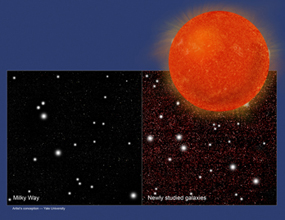New dark matter detector begins search for invisible particles
Scientists heard their first pops last week in an experiment that searches for signs of dark matter in the form of tiny bubbles.
They will need to analyze them further in order to discern whether dark matter caused any of the COUPP-60 experiment’s first bubbles at the SNOLAB underground science laboratory in Ontario, Canada. Dark matter accounts for nearly 90 percent of all matter in the universe, yet it is invisible to telescopes.
“Our goal is to make the most sensitive detector to see signals of particles that we don’t understand,” said Hugh Lippincott, a postdoctoral scientist with Fermi National Accelerator Laboratory. Lippincott has spent much of the past several months leading the installation of the one-of-a-kind detector at SNOLAB, 1.5 miles underground. (more…)

